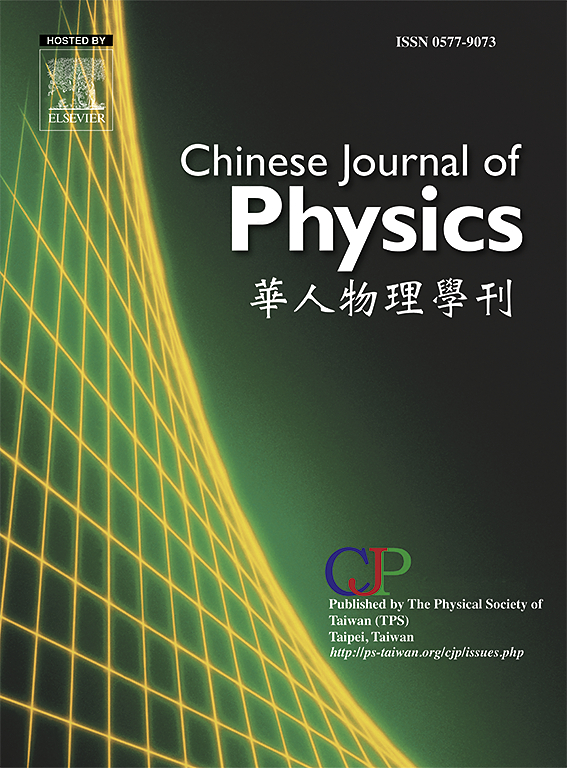Improving the key rate of decoy state-based QKD scheme using self-healing technique
IF 4.6
2区 物理与天体物理
Q1 PHYSICS, MULTIDISCIPLINARY
引用次数: 0
Abstract
In any QKD scheme, a train of encoded laser pulses is shared between legitimate users as a raw key. The actual key is extracted from the raw key by eliminating eavesdropping and other loss factors in the communication channel. Several pulses are used in error estimation and correction, resulting in a low key generation rate. It can be improved by reducing losses in the communication channel and the probability of eavesdropping. That can effectively be done by reducing the amount of physical communication. The self-healing technique of physical communication at alternate time intervals and no communication in between is proposed and implemented in the decoy-state-based quantum key distribution (QKD) protocol. Legitimate users can generate the uncommunicated state from the pre- and post-communicated states. Since physical communication is reduced by half, loss of the signal states in the channel and eavesdropping are reduced; it is analyzed and assessed. Security analysis reveals that the key generation rate and the length of secure communication are improved. Data encryption is done through phase-encoded weak coherent laser pulses. In the proposed protocol, legitimate users use a pre-shared one-way function to select bases and intensities of the signal states. Both participate in setting the argument of the one-way function. It ensures user authentication, and no separate authentication protocol is required. This, in turn, eliminates the man-in-the-middle attack.
The one-way function ensures a basis correlation between the subsequent pulses and, to some extent, intensity correlation. It helps legitimate users encode and decode the signal and reduces measurement uncertainty. But, the one-way function being unknown to Eve, the signal states are random to her. So, her measurement is subject to quantum uncertainty. The self-healing technique further complicates the situation as Eve has no access to the uncommunicated pulses. From that point of view, the data leakage to Eve is less. However, Eve’s intervention may create little loss of signal states. The proposed self-healing technique allows for its complete identification and assessment. An error bound corresponding to it is determined, and the key generation rate is calculated.

利用自愈技术提高基于诱饵状态的QKD方案的密钥率
在任何QKD方案中,一列编码的激光脉冲作为原始密钥在合法用户之间共享。通过消除通信信道中的窃听和其他丢失因素,从原始密钥中提取实际密钥。在误差估计和校正中使用了多个脉冲,导致密钥生成率较低。可以通过减少通信信道的损耗和被窃听的概率来改进。这可以通过减少身体交流的数量来有效地实现。在基于诱饵态的量子密钥分发(QKD)协议中,提出并实现了交替时间间隔物理通信且其间不通信的自修复技术。合法用户可以从通信前和通信后的状态生成未通信状态。由于物理通信减少了一半,信道中信号状态的损失和窃听减少了;它被分析和评估。安全性分析表明,该算法提高了密钥生成速率和安全通信长度。数据加密是通过相位编码的弱相干激光脉冲完成的。在提出的协议中,合法用户使用预共享的单向函数来选择信号状态的基和强度。两者都参与设置单向函数的参数。它确保了用户身份验证,并且不需要单独的身份验证协议。这反过来又消除了中间人攻击。单向函数保证了后续脉冲之间的基相关性,并在一定程度上保证了强度相关性。它可以帮助合法用户对信号进行编码和解码,并减少测量的不确定性。但是,单向函数对夏娃来说是未知的,信号状态对她来说是随机的。所以,她的测量受到量子不确定性的影响。这种自我修复技术使情况进一步复杂化,因为夏娃无法接触到未交流的脉冲。从这个角度来看,泄露给Eve的数据更少。然而,伊芙的干预可能会造成信号状态的少许损失。提出的自我修复技术允许对其进行完整的识别和评估。确定与之相对应的错误界,并计算密钥生成率。
本文章由计算机程序翻译,如有差异,请以英文原文为准。
求助全文
约1分钟内获得全文
求助全文
来源期刊

Chinese Journal of Physics
物理-物理:综合
CiteScore
8.50
自引率
10.00%
发文量
361
审稿时长
44 days
期刊介绍:
The Chinese Journal of Physics publishes important advances in various branches in physics, including statistical and biophysical physics, condensed matter physics, atomic/molecular physics, optics, particle physics and nuclear physics.
The editors welcome manuscripts on:
-General Physics: Statistical and Quantum Mechanics, etc.-
Gravitation and Astrophysics-
Elementary Particles and Fields-
Nuclear Physics-
Atomic, Molecular, and Optical Physics-
Quantum Information and Quantum Computation-
Fluid Dynamics, Nonlinear Dynamics, Chaos, and Complex Networks-
Plasma and Beam Physics-
Condensed Matter: Structure, etc.-
Condensed Matter: Electronic Properties, etc.-
Polymer, Soft Matter, Biological, and Interdisciplinary Physics.
CJP publishes regular research papers, feature articles and review papers.
 求助内容:
求助内容: 应助结果提醒方式:
应助结果提醒方式:


